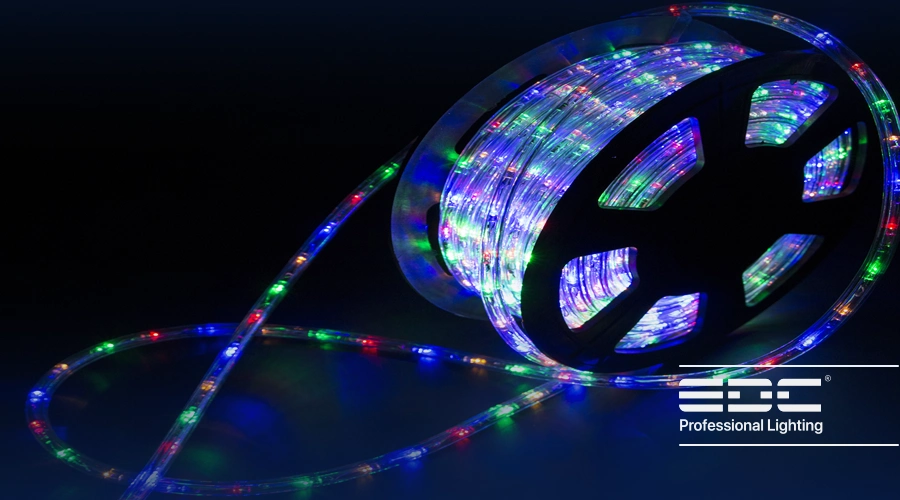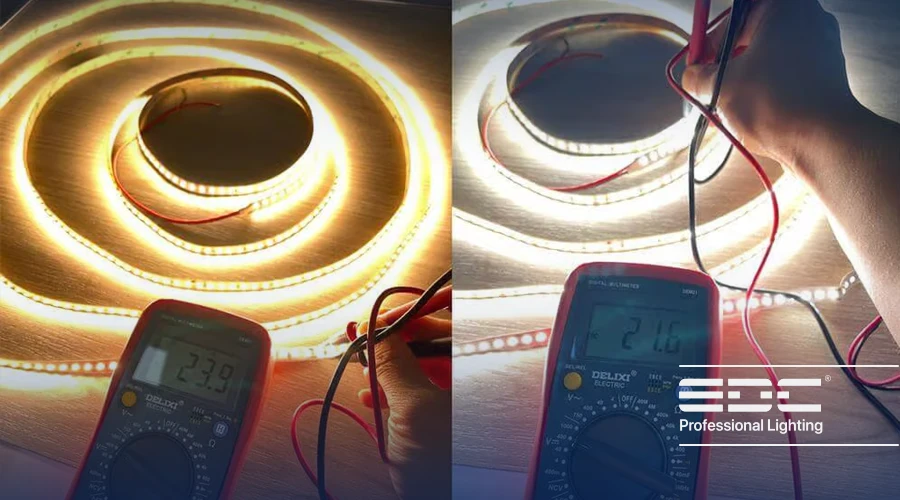Nowadays, efficient use of energy and control of electricity consumption have become very important. One of the things that can help save energy is the use of LED strings. But how can the electricity consumption of these strings be calculated and controlled? In this article from EDC, we will examine the factors affecting the electricity consumption of LED strings and explain the calculation methods with examples so that you have a better understanding of how to calculate the electricity of an LED string.
Why is it important to calculate the electricity consumption of an LED string?

Calculating the power consumption of LED strips is important for the following reasons:
Cost control: By knowing the exact amount of electricity consumption, you can estimate and plan for electricity costs.
Choosing the right strip: When buying LED strips, by knowing the amount of electricity consumption required, you can choose a strip with the right power.
Optimizing energy consumption: By identifying the strips that consume the most electricity, you can replace them with less energy-efficient models.
Power consumption in types of strips
In this section, we will examine the power consumption of different types of strips:
Strip strips (LED Strip Lights)
Strip strips are one of the most popular types of strips that are commonly used for decorative lighting and decorative applications. These strips have a good power consumption due to their slim design. The average power consumption of this type of rope is about 4.8 watts per meter.
Power Consumption of LED Rope Lights

Due to the plastic covering around the bulbs and their flexible design, hose strings are used in many decorative and ambient lighting applications. The power consumption of these strings is on average about 7 watts per meter, which is more than the power consumption of strip strings.
SMD or Surface Mount Device LED strings
Due to their more advanced nature, SMD strings usually consume more power than strip and hose strings. The power consumption of this type of string is about 12 watts per meter. These strings are used in professional lighting due to their high brightness and excellent light quality.
Power consumption of branch LED
The power consumption of branch LED depends on factors such as the number of branches, the total length of the string, and the type of LEDs used. In general, these types of strings use less electricity than incandescent bulbs and even some other LED strings due to the use of energy-efficient LEDs.
Average consumption: The power consumption of branched LED strings is usually between 6 and 10 watts per meter. (This amount can vary depending on the number of branches and the type of LEDs used.)
String length: The total length of the branched string also affects the amount of electricity consumed. For example, a branched LED string with a length of 5 meters and a consumption of 8 watts per meter will have a total electricity consumption of 40 watts.
Comparison of electricity consumption of types of strings
See the electricity consumption of different types of strings in the table below:
| Thread type | Electricity consumption |
| Ribbon threads | About 4.8 watts/meter |
| Hose reels | About 4.8 watts/meter |
| SMD strands | About 12 watts/meter |
| Branched threads | About 6 to 10 watts/meter |
If your strings’ power consumption is much higher than these values, your electricity consumption is likely high and you should take steps to optimize it.
How to calculate the power consumption of an LED string
To calculate the power consumption of an LED string, you can use the following formula:
Power consumption (watts) = String power consumption (watts per meter) × String length (meters)
Example: Suppose you have a strip LED string with a power consumption of 4.8 watts per meter and a length of 10 meters. The power consumption of this string is equal to:
4.8×10=48 watts
This means that this string consumes 48 watts of electricity per hour.
How to optimize the power consumption of strings?
There are various methods to reduce the power consumption of strings, including:
Choosing strings with lower consumption
One of the easiest ways to optimize electricity consumption is to choose strings with lower consumption. For example, SMD and COB filaments, due to their more advanced nature, consume less energy than older models.
Using Timers and Controllers

Using timers and controllers can significantly reduce electricity consumption. By setting a timer, you can control when the strings are on and prevent them from being on during unnecessary hours.
Adjust the brightness
In many cases, there is no need for full brightness all day or night. By using brightness settings and choosing options such as dimming settings or single-color lights, you can reduce electricity consumption.
Use high-efficiency strings
High-efficiency LED strings use less electricity than conventional models due to their design and technology.
Check and optimize the installation
Make sure that the string is installed correctly and that there are no faulty connections or problems with the power supply system. Poor connections lead to increased electricity consumption and reduced string efficiency.
Use new technologies
Checking and using these new technologies can help reduce electricity consumption. For example, smart and automated technologies can automatically adjust power consumption based on demand.
LED String Voltage

Voltage is one of the most important characteristics of LED strings. Choosing the right voltage for strings is very important. For more information about LED string voltage, you can refer to the article Choosing LED String Voltage.
Types of Energy-Saving EDC LED Strings
By purchasing energy-saving LED strings from EDC, you can light your home or office at an affordable cost. These strings not only consume very little energy and help reduce electricity costs, but they also have a long lifespan and durability. EDC offers a wide range of LED strings with various designs and colors, allowing you to choose the right one for every taste. By purchasing from EDC, you can be sure of the quality of products and after-sales service.